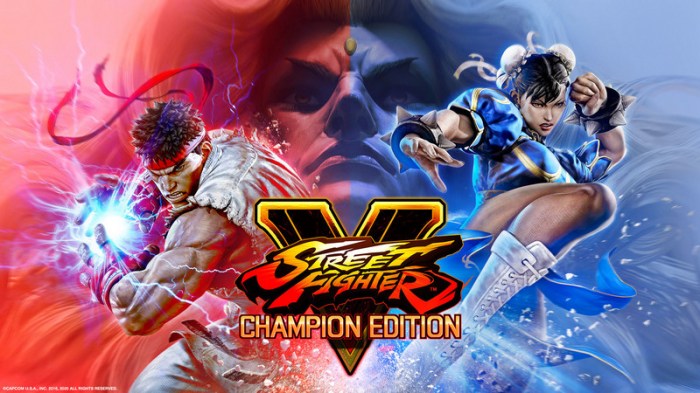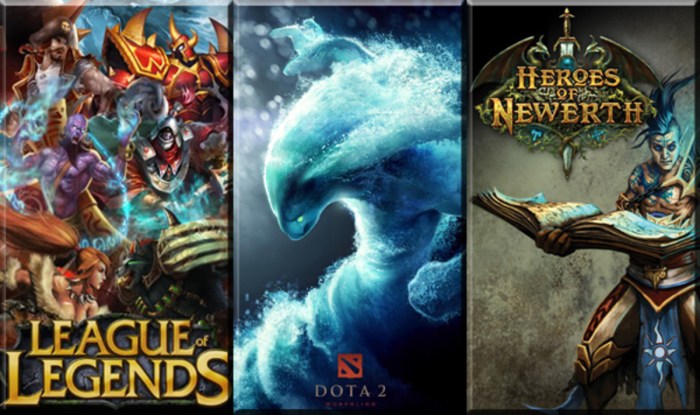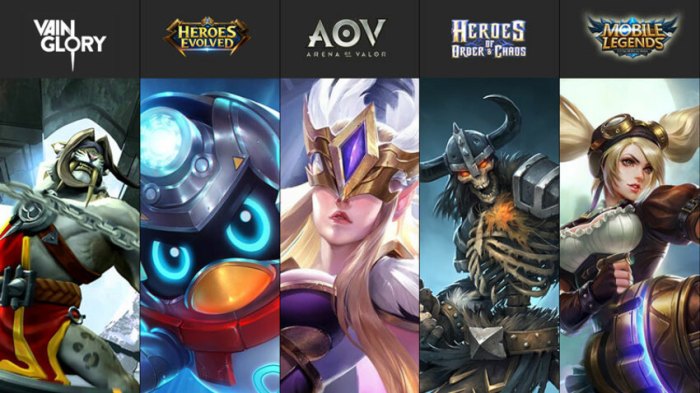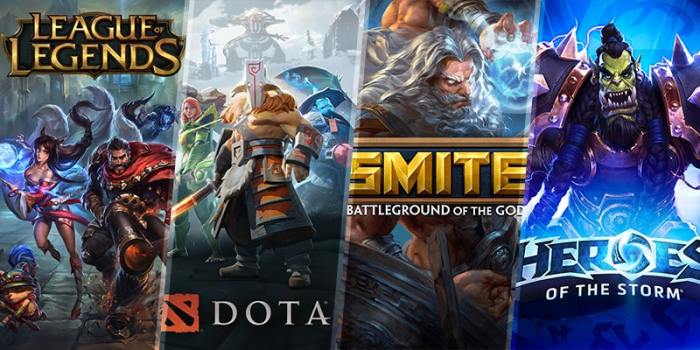Game Genres (MOBA, FPS, etc.)—they’re everywhere! From the epic team battles of MOBAs to the adrenaline-pumping action of FPS games, the world of video games is a diverse landscape shaped by distinct genres. This exploration dives into the core mechanics, historical evolution, and future trends of these captivating categories, revealing the fascinating stories behind their creation and enduring appeal.
We’ll unpack the differences between genres, explore exciting hybrids, and even peek into the future of gaming.
We’ll cover the defining characteristics of major genres like MOBAs, FPS, RPGs, and strategy games, comparing their gameplay mechanics and analyzing their unique player experiences. We’ll also trace the evolution of these genres, highlighting key innovations and influential titles. Get ready to level up your understanding of the gaming world!
Defining Game Genres

So, you wanna talk game genres? It’s a pretty broad topic, but basically, a game genre is a way of categorizing video games based on shared characteristics. Think of it like musical genres – you’ve got rock, pop, jazz, etc., all with their own sounds and styles. Similarly, games are grouped together based on their gameplay mechanics, setting, story, and overall feel.
This helps players find games they’ll enjoy and developers understand market trends.Game genres aren’t always neatly defined; many games blend elements from multiple genres, creating hybrid genres. For example, a game might be both an RPG and a strategy game, combining role-playing elements with strategic decision-making. This blurring of lines makes genre classification sometimes subjective, but it’s still a useful tool for organization and understanding.
Key Characteristics of Different Genres
Different game genres are distinguished by a number of key characteristics. These include the game’s perspective (first-person, third-person, top-down), control scheme (keyboard and mouse, controller, touch screen), primary objective (exploration, combat, puzzle-solving), and overall tone (serious, humorous, dark). For example, a first-person shooter (FPS) emphasizes fast-paced combat from a first-person perspective, while a massively multiplayer online battle arena (MOBA) focuses on strategic team combat with a top-down perspective.
Role-playing games (RPGs) typically involve character development and narrative-driven gameplay, often incorporating elements of exploration and combat. Strategy games require players to make strategic decisions to achieve victory, while puzzle games emphasize problem-solving.
Gameplay Mechanics Comparison: FPS, RPG, and MOBA
Let’s compare the core gameplay mechanics of three distinct genres: First-Person Shooters (FPS), Role-Playing Games (RPGs), and Multiplayer Online Battle Arenas (MOBAs). FPS games prioritize fast-paced, direct combat, relying on precise aiming and quick reflexes. Players typically control a single character with limited customization options, focusing on immediate action. RPGs, on the other hand, emphasize character progression and narrative.
Players often control a party of characters, each with unique abilities and stats, and engage in a combination of combat, exploration, and dialogue. The focus is on long-term character development and story progression. MOBAs are team-based strategy games where players control a single character with unique abilities and work collaboratively to destroy the opposing team’s base. The gameplay is characterized by strategic decision-making, resource management, and coordinated teamwork.
Game Genre Categorization
The following table categorizes various game genres based on their primary gameplay elements. Note that many games blend genres, making strict categorization difficult.
| Genre | Perspective | Control Scheme | Primary Objective | Example |
|---|---|---|---|---|
| First-Person Shooter (FPS) | First-person | Keyboard and Mouse/Controller | Eliminate opponents | Call of Duty |
| Role-Playing Game (RPG) | Various (first-person, third-person, isometric) | Keyboard and Mouse/Controller | Character progression and story completion | The Witcher 3 |
| Massively Multiplayer Online Battle Arena (MOBA) | Top-down/Isometric | Keyboard and Mouse | Destroy the enemy base | League of Legends |
| Strategy | Top-down/Isometric | Keyboard and Mouse | Resource management and tactical combat | StarCraft II |
| Puzzle | Various | Keyboard/Mouse/Touch | Solve puzzles | Portal 2 |
Evolution of Popular Genres

The gaming landscape is constantly shifting, with genres evolving and branching off in unexpected ways. Understanding the history of these genres provides valuable insight into current trends and future possibilities. This section will explore the evolution of three major genres: MOBAs, FPS games, and RPGs, highlighting key moments and influential titles.
MOBA Genre Evolution
The MOBA (Multiplayer Online Battle Arena) genre, as we know it today, didn’t spring up overnight. Its roots lie in the custom games created within the Warcraft III: Reign of Chaos and StarCraft universes. These custom maps, notably “Defense of the Ancients” (DotA), laid the foundation for the genre’s core mechanics: two teams battling for control of a map, accumulating resources to upgrade their heroes, and ultimately destroying the opposing team’s base.
The popularity of these custom maps fueled the demand for a standalone MOBA experience.
Rise of First-Person Shooters (FPS), Game Genres (MOBA, FPS, etc.)
The FPS genre’s rise to prominence can be attributed to several factors. Early titles like Wolfenstein 3D and Doom introduced the exhilarating first-person perspective and fast-paced action that captivated players. The advancement of technology, allowing for increasingly realistic graphics and immersive sound design, further fueled the genre’s growth. The introduction of online multiplayer capabilities, starting with games like Quake and Counter-Strike, created a vibrant and competitive community that significantly boosted the genre’s popularity.
This online aspect allowed for persistent engagement and fostered a sense of community among players. The competitive scene that emerged, with professional tournaments and esports leagues, added another layer of appeal, further solidifying the FPS genre’s position in the gaming world.
Role-Playing Game (RPG) Innovations
RPGs have undergone a significant transformation throughout their history. Early text-based RPGs like Zork and Dungeon Master established the fundamental elements of character creation, narrative progression, and exploration. The transition to graphical interfaces with titles like Ultima VII and Diablo revolutionized the genre, allowing for more immersive and visually engaging experiences. The introduction of real-time combat in games like Diablo, contrasted with the turn-based systems of earlier RPGs, opened up new possibilities for gameplay.
Further innovations included the integration of open-world environments ( The Elder Scrolls III: Morrowind), complex character customization systems ( Neverwinter Nights), and compelling storylines ( The Witcher 3: Wild Hunt).
Key Developments in the MOBA Genre: A Timeline
The following timeline illustrates significant milestones in the evolution of the MOBA genre, showcasing the progression from its humble beginnings to its current state.
- 1998: StarCraft is released, paving the way for custom map development that would later heavily influence the MOBA genre.
- 2003: “Defense of the Ancients” (DotA) emerges as a custom map within Warcraft III: Reign of Chaos, establishing the core mechanics of the MOBA genre.
- 2009: League of Legends is released, establishing itself as a major player in the MOBA market and introducing a broader audience to the genre.
- 2010: Heroes of Newerth, a direct competitor to League of Legends, further expands the MOBA market.
- 2012: Dota 2, a standalone version of the original DotA, is released, continuing the legacy and refining the gameplay.
- 2015: Smite, a MOBA with a third-person perspective, demonstrates the genre’s adaptability and willingness to experiment with different gameplay mechanics.
Genre Hybrids and Subgenres: Game Genres (MOBA, FPS, Etc.)

Genre hybridization is a major force shaping the modern gaming landscape. It’s not just about mashing genres together; successful hybrids thoughtfully integrate core mechanics and design philosophies to create something new and engaging. This blending of established genres often leads to the emergence of exciting subgenres, pushing the boundaries of what’s considered possible in game design.The creation of subgenres within established genres is a natural evolutionary process.
As developers experiment with different mechanics and gameplay loops, variations arise that become distinct enough to warrant their own categorization. This allows for more focused design and marketing, appealing to specific player preferences. The impact of genre hybridization is significant, offering players diverse experiences and driving innovation within the industry.
Examples of Successful Genre Hybrids
Several games have successfully blended genres to create unique and compelling experiences. For instance,
- Diablo* pioneered the action RPG (ARPG) genre by combining the action-oriented gameplay of action games with the character progression and loot systems of role-playing games. Similarly,
- Borderlands*, a first-person shooter (FPS) with RPG elements, stands out for its humorous writing and vast arsenal of customizable weapons. The
- Left 4 Dead* series masterfully blended cooperative FPS gameplay with elements of survival horror, creating a tense and rewarding experience.
- Plants vs. Zombies*, a tower defense game with puzzle elements, successfully combined strategic gameplay with charming visuals and addictive mechanics. Finally,
- Stardew Valley* is a remarkable example of a hybrid, successfully blending farming simulation with RPG and life simulation elements. Each of these examples demonstrates how the thoughtful combination of genres can result in something greater than the sum of its parts.
Subgenre Emergence
The battle royale subgenre, which exploded in popularity with the success of
- PlayerUnknown’s Battlegrounds* and
- Fortnite*, provides a clear example of subgenre evolution within an established genre (FPS). Battle royale games take the core FPS mechanics of shooting and combat and integrate them into a large-scale survival game with a shrinking play area, creating a unique high-stakes experience focused on last-man-standing gameplay. Other examples include the emergence of rogue-lites within the RPG genre, adding permadeath and procedural generation to traditional RPG gameplay, and the rise of MOBA-like gameplay in various genres, such as the team-based combat found in many fighting games.
Impact of Genre Hybridization on the Gaming Landscape
Genre hybridization has significantly expanded the possibilities within the gaming landscape. It has led to a greater diversity of gameplay experiences, catering to a wider range of player preferences. Furthermore, it fosters innovation by encouraging developers to experiment with new mechanics and design approaches. The constant blending of genres keeps the gaming industry fresh and dynamic, preventing stagnation and ensuring a continuous flow of creative and engaging titles.
The resulting competition between these hybrid genres pushes developers to improve their games and further refine the hybrid formula.
Table of Genre Hybrids
| Game | Primary Genre | Secondary Genre(s) | Defining Features |
|---|---|---|---|
| Diablo II | Action | RPG | Loot-driven progression, dungeon crawling, character classes |
| Borderlands 2 | First-Person Shooter | RPG | Vast weapon variety, character skill trees, loot-based progression |
| Left 4 Dead 2 | First-Person Shooter | Survival Horror | Cooperative gameplay, zombie hordes, strategic resource management |
| Plants vs. Zombies | Tower Defense | Puzzle | Strategic plant placement, diverse enemy types, humorous presentation |
| Stardew Valley | Farming Simulation | RPG, Life Simulation | Farming, relationship building, crafting, exploration, character progression |
Gameplay Mechanics and Player Experience

Understanding gameplay mechanics is crucial to appreciating the diverse experiences offered by different game genres. The core mechanics directly impact player interaction, strategic depth, and overall immersion, shaping the unique appeal of each genre. This section will explore these mechanics, focusing on the differences and similarities between MOBAs and FPS games, and then broaden the discussion to include the role of narrative and a comparison of player experiences across several popular genres.
MOBA and FPS Gameplay Mechanics: A Comparison
MOBAs (Multiplayer Online Battle Arenas), such as League of Legends and Dota 2, emphasize strategic team-based combat. Core mechanics revolve around controlling a “hero” with unique abilities, farming resources, destroying enemy structures, and coordinating with teammates to achieve victory. Player interaction is constant and multifaceted, requiring communication, coordination, and strategic decision-making in team fights and lane management. Strategic depth arises from the vast hero pool, item builds, and map awareness.
FPS (First-Person Shooters), like Counter-Strike and Call of Duty, focus on fast-paced, individual or team-based combat using firearms. Player interaction is often more direct and immediate, involving close-quarters combat, tactical maneuvers, and aiming precision. Strategic depth comes from map knowledge, weapon selection, and understanding enemy movements and strategies. While both genres require skill and teamwork, MOBAs generally present a higher level of strategic complexity due to their intricate hero interactions and economic systems.
Design Choices for Engaging Player Experiences
Engaging and immersive experiences are achieved through a combination of factors. In MOBAs, the constant ebb and flow of combat, the feeling of progression through leveling and item acquisition, and the impact of individual actions on the team’s overall success contribute significantly to player engagement. The social aspect, including teamwork and communication, is also a major element. FPS games, on the other hand, leverage the visceral thrill of combat, the responsiveness of controls, and the satisfying feeling of precise aiming and skillful maneuvers.
Design choices such as level design, weapon balance, and the pacing of gameplay all play critical roles in shaping the player experience. For example, a well-designed FPS map can encourage strategic play and tactical maneuvering, while a poorly designed one can feel repetitive and frustrating. Similarly, a well-balanced weapon set provides players with diverse options, preventing any single weapon from becoming overwhelmingly dominant.
Narrative and Storytelling in Shaping Player Experience
Narrative and storytelling play a significant role in shaping player immersion and engagement, even in genres not traditionally associated with strong narratives. In MOBAs, lore and character backstories can enrich the player experience, adding depth and context to the gameplay. While the primary focus is on competitive gameplay, understanding the characters’ motivations and relationships can enhance the overall enjoyment.
FPS games can use narrative to provide context for the gameplay, create a sense of immersion, and enhance the player’s emotional connection to the game world. Examples include single-player campaigns that tell compelling stories or multiplayer modes with a clear overarching narrative. The narrative can even influence the gameplay mechanics; for instance, a story about a specific historical conflict might influence the weapons and environments in an FPS.
Player Experience Comparison Across Genres
| Genre | Pacing | Social Interaction | Skill Ceiling |
|---|---|---|---|
| MOBA | Strategic and deliberate, with bursts of intense action | High; requires significant teamwork and communication | Very high; mastering heroes, strategies, and team coordination requires extensive practice |
| FPS | Fast-paced and action-oriented, with moments of tactical planning | Varies widely depending on the mode; can range from solo play to highly coordinated team efforts | High; requires precise aiming, quick reflexes, and strategic thinking |
| RPG (Role-Playing Game) | Variable; can range from slow and methodical exploration to fast-paced combat encounters | Can be minimal in single-player RPGs or extensive in massively multiplayer online RPGs (MMORPGs) | Variable; depends on the complexity of the game’s systems and mechanics |
The Impact of Technology and Platforms
Technological advancements have fundamentally reshaped the landscape of video games, driving the evolution of genres and influencing player experiences in profound ways. The capabilities of hardware and software directly impact what’s possible in game design, from simple 2D sprites to incredibly detailed 3D worlds and complex physics simulations. Simultaneously, the platform on which a game is played – be it PC, console, or mobile – significantly shapes its design, accessibility, and overall popularity.Technological advancements have directly influenced the evolution of game genres.
Early arcade games, limited by their hardware, were predominantly simple, action-oriented titles. The introduction of more powerful processors and better graphics cards allowed for the development of more complex RPGs, and later, the immersive worlds of open-world games. The rise of online connectivity enabled the explosive growth of massively multiplayer online games (MMOs) and MOBAs. Each technological leap has unlocked new possibilities, pushing the boundaries of what was previously considered achievable.
Platform-Specific Genre Design
The platform a game is released on significantly affects its design and appeal. PC gaming, historically known for its high-end hardware and customizable controls, has fostered the growth of complex strategy games, simulation titles, and highly competitive FPS games. Consoles, with their focus on ease of use and accessibility, have often favored genres that offer a more streamlined experience, such as action-adventure games and sports titles.
Mobile gaming, characterized by its portability and touch-based controls, has seen a surge in popularity of casual games, puzzle games, and mobile-first MOBAs optimized for shorter play sessions. Each platform’s unique characteristics dictate the design choices and gameplay mechanics, shaping the overall player experience.
Technological Limitations Shaping Genre Conventions
Historically, technological limitations have directly impacted genre conventions. The low resolution and processing power of early consoles resulted in simple, pixelated graphics and limited gameplay mechanics. This naturally led to the dominance of 2D platformers and simpler arcade games. The limitations of early internet connectivity influenced the design of online games, often resulting in simpler multiplayer experiences with fewer players.
These constraints forced developers to be creative and innovative within their limitations, resulting in unique game designs that are often viewed as classics today. As technology progressed, these limitations were overcome, opening up new avenues for innovation and pushing the boundaries of game design.
A Fictional Game Concept: “Echoes of the Aether”
“Echoes of the Aether” is a fictional open-world, sci-fi RPG designed for PC and next-gen consoles. This game leverages advancements in real-time ray tracing to create stunningly realistic visuals, with dynamic lighting and highly detailed environments. The game’s vast open world is procedurally generated using advanced algorithms, ensuring high replayability and a unique experience for each player. Furthermore, the game utilizes advanced AI to create believable non-player characters (NPCs) with complex behaviors and motivations.
The game’s unique feature, “Aether Weaving,” allows players to manipulate the environment in real-time using advanced physics engines and particle effects, creating dynamic solutions to puzzles and combat encounters. This feature is only possible due to the powerful processing capabilities of modern hardware. The game’s story, focusing on exploration and unraveling a mysterious alien civilization, benefits from the immersive visuals and complex interactions enabled by these technological advancements.
FAQs
What’s the difference between a MOBA and an RTS?
MOBAs (Multiplayer Online Battle Arenas) focus on direct player-controlled hero combat within a limited arena, while RTS (Real-Time Strategy) games involve base building, resource management, and broader battlefield control.
Are indie games usually confined to specific genres?
Nope! Indie games span all genres, often experimenting with genre blends and pushing creative boundaries.
How do VR and AR impact game genres?
VR and AR technologies offer immersive experiences, particularly beneficial to FPS, RPGs, and simulation games, creating entirely new gameplay possibilities.
What are some emerging game genres?
We’re seeing growth in genres like rogue-lites, life sims with more complex mechanics, and games focused on social interaction and player-generated content.
